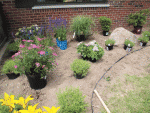
Top 10 Planting Design Tips
1. Try massing plants rather than having one of everything.
2. Plant in odd numbers, though once you reach ten plants, you can ignore this rule.
3. Make a nice composition of plant forms. Add a little variety by mixing different forms, yet make sure you still have repetition.
4. Mix plant textures. Combine plants with large leaves and plants with small leaves to make your garden pop.
5. When choosing colors limit your choice by picking a theme (IE: monochromatic colors, complimentary colors, etc)
6. Consider all plant heights… especially those itsy bitsy plants (12″ or less) for the front row. This make a great border.
7. Consider winter interest too. (Twigs, berries, bark and flowing grass)
too. (Twigs, berries, bark and flowing grass)
8. Fill your beds with plants! This not only keeps down weeds, but makes your garden lush. Do you really want to look at empty planting beds.
9. Layer your plants. Why not even have two, three, or even five rows.
10. If you have a long border to fill, create a pattern with your plants.
Most importantly experiment and have fun. If something doesn’t work out, try a new combination… until you fall in love with it.








